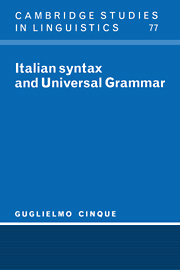Book contents
- Frontmatter
- Contents
- Introduction
- 1 On extraction from NP in Italian
- 2 On the theory of relative clauses and markedness
- 3 Bare quantifiers, quantified NPs, and the notion of operator at S-structure
- 4 On si constructions and the theory of arb
- 5 Ci si
- 6 On a difference between English and Italian “Complement Object Deletion” constructions
- 7 Ergative adjectives and the Lexicalist Hypothesis
- 8 The pseudo-relative and ACC-ing constructions after verbs of perception
- 9 On leftward movement of tutto in Italian
- 10 On the evidence for partial N-movement in the Romance DP
- References
- Index
Introduction
Published online by Cambridge University Press: 01 October 2009
- Frontmatter
- Contents
- Introduction
- 1 On extraction from NP in Italian
- 2 On the theory of relative clauses and markedness
- 3 Bare quantifiers, quantified NPs, and the notion of operator at S-structure
- 4 On si constructions and the theory of arb
- 5 Ci si
- 6 On a difference between English and Italian “Complement Object Deletion” constructions
- 7 Ergative adjectives and the Lexicalist Hypothesis
- 8 The pseudo-relative and ACC-ing constructions after verbs of perception
- 9 On leftward movement of tutto in Italian
- 10 On the evidence for partial N-movement in the Romance DP
- References
- Index
Summary
The articles collected here, some of which have not been published before, deal with different aspects of the syntax of Italian, including properties of the structure of nominal phrases, impersonal si constructions, and the particular type of finite complements of perception verbs sometimes called “pseudo-relatives.”
In some of the articles the analysis of the Italian data may be seen to bear on more general, comparative and theoretical, questions. Often, independently established principles of the theory are applied to the intricacies of the data and argued to reveal unforeseen patterns, or solutions for certain long-standing anomalies (as in the study of relative clauses in chapter 2, or in the study of si constructions in chapter 4). In other cases, the facts of Italian are shown to offer a privileged access to certain theoretical conclusions, not easily reachable from the vantage point of other (well-studied) languages (as is the case with the notion of syntactic operator in chapter 3, and the expected existence of a class of ergative, or unaccusative, adjectives, in chapter 7).
Although written over a period of more than ten years, these essays are all cast in one or another version of the so-called Principles and Parameters theory, essentially stemming from the notion of parametrized principle in Chomsky's 1979 Pisa lectures (Chomsky 1981).
The revolutionary and heuristic values of this development in the generative program initiated by Chomsky over forty years ago have probably been greater than those of any other, previous or later, development.
Information
- Type
- Chapter
- Information
- Italian Syntax and Universal Grammar , pp. 1 - 6Publisher: Cambridge University PressPrint publication year: 1996
